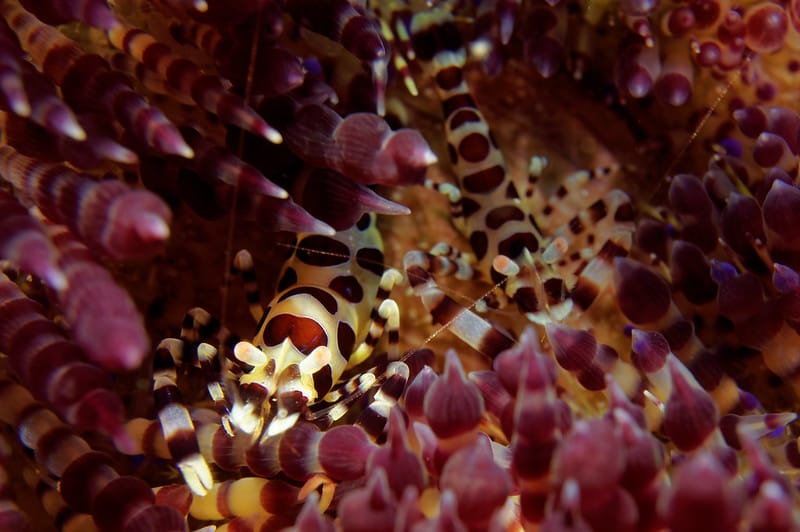
Table of Contents
Introduction
When divers think of the best diving Philippines, vibrant coral reefs and massive pelagic species often come to mind. However, for macro photography enthusiasts and lovers of rare marine life, Muck Diving Anilao is an unparalleled experience.
Anilao, often referred to as the “nudibranch capital of the world,” is one of the most famous muck diving destinations in Asia. Its black volcanic sand and nutrient-rich waters create the perfect environment for some of the rarest and most fascinating marine creatures, from blue-ringed octopuses to flamboyant cuttlefish.
This guide will take you through everything you need to know about Muck Diving Anilao, including what to expect, the best dive sites, and how it compares to other diving hotspots like Coron to El Nido.
What is Muck Diving?
Muck diving refers to a type of diving done over sandy, silty, or muddy seabeds, rather than traditional coral reefs. Instead of large fish or sharks, divers search for tiny, well-camouflaged creatures that are almost impossible to spot without a trained eye.
📍 Why is it Special?
✔ Perfect for macro photography.
✔ Offers a chance to see rare and exotic species.
✔ Ideal for slow-paced, detailed diving experiences.
What Can You See During Muck Diving in Anilao?
Anilao is a biodiversity hotspot filled with weird, wonderful, and colorful creatures. Here are some of the most sought-after critters:
1. Rare Octopuses and Cephalopods
✔ Blue-ringed octopus – Tiny but extremely venomous!
✔ Mimic octopus – Can impersonate other sea creatures.
✔ Flamboyant cuttlefish – A small but vibrantly colored species.
2. Exotic Shrimp and Crustaceans
✔ Harlequin shrimp – Feeds on starfish and has intricate patterns.
✔ Mantis shrimp – Known for its powerful punch and incredible eyesight.
3. Unique and Camouflaged Fish
✔ Frogfish – Masters of disguise that blend into their environment.
✔ Ghost pipefish – Delicate and beautifully patterned.
✔ Seamoths – Small, dragon-like fish that “walk” along the seabed.
4. Nudibranchs and Other Macro Critters
✔ Over 600 species of nudibranchs – Some of the most colorful marine animals in the world.
✔ Pygmy seahorses – Tiny, fragile, and incredibly rare.
📍 Best Time for Macro Photography: November to May, when visibility is best and critters are more active.
Best Muck Diving Sites in Anilao
Anilao has dozens of world-class muck diving sites, each offering different species and unique underwater landscapes.
1. Secret Bay
✔ Best for: Nudibranchs, seahorses, and frogfish.
✔ Depth: 5-20 meters.
✔ Why it’s Special: Known for its high concentration of macro critters.
2. Basura (The Junkyard)
✔ Best for: Blue-ringed octopuses, mantis shrimp, and pipefish.
✔ Depth: 3-18 meters.
✔ Why it’s Special: Artificial debris attracts tons of unique marine life.
3. Mainit Point
✔ Best for: Flamboyant cuttlefish, bobtail squid, and ghost pipefish.
✔ Depth: 5-25 meters.
✔ Why it’s Special: A mix of muck diving and vibrant soft corals.
4. Anilao Pier
✔ Best for: Night diving, rare crustaceans, and juvenile fish.
✔ Depth: 3-12 meters.
✔ Why it’s Special: One of the best night diving sites in Anilao.
📍 Pro Tip: Bring a macro lens for your camera, as most creatures here are less than 5 cm in size!
How Does Muck Diving Anilao Compare to Coron – El Nido?
While Muck Diving Anilao is famous for small macro critters, the Coron – El Nido region is known for shipwrecks, coral reefs, and large marine species.
Muck Diving Anilao vs. Coron to El Nido
📍 Which One to Choose?
✔ If you love macro photography and rare critters, choose Muck Diving Anilao.
✔ If you want wrecks, coral reefs, and big fish, go for Coron to El Nido.
✔ Best Option? Visit both! Many divers combine a trip to Anilao with Coron – El Nido to get the full Philippine diving experience.
| Feature | Muck Diving Anilao | Coron to El Nido |
|---|---|---|
| Main Attraction | Macro creatures | Shipwrecks & coral reefs |
| Best for | Nudibranchs, frogfish, octopuses | Large pelagics, sharks, rays |
| Diving Style | Slow-paced, detailed exploration | Deep diving, drift diving |
| Depth Range | 3-25 meters | 5-40 meters |
| Best Time to Visit | November – May | October – June |
Tips for a Successful Muck Diving Trip in Anilao
✔ Bring a Dive Light – Helps spot hidden critters in the sand.
✔ Use a Macro Lens – Most creatures are tiny and require detailed photography.
✔ Stay Patient – Muck diving is about searching for small details.
✔ Be Gentle with the Seabed – Avoid stirring up sediment to keep visibility clear.
📍 Eco-Friendly Diving Tip: Always respect marine life—never touch or harass critters, and support dive shops that practice sustainable tourism.
FAQs About Muck Diving Anilao
1. What is Muck Diving Anilao famous for?
✔ It’s known for rare critters, including nudibranchs, frogfish, octopuses, and pipefish.
2. Can beginners try muck diving?
✔ Yes! Muck diving is done in shallow, calm waters, making it beginner-friendly.
3. Is Muck Diving Anilao better than other sites in the Philippines?
✔ It’s one of the best macro diving locations in Asia, rivaling Lembeh, Indonesia.
4. When is the best time to go muck diving in Anilao?
✔ November to May, when visibility is high and marine life is most active.
5. Can I combine Anilao with Coron – El Nido?
✔ Yes! Many divers visit both regions for a complete Philippine diving adventure.
Conclusion
Muck Diving Anilao is a macro diver’s paradise, offering some of the rarest and most bizarre critters in the ocean. While it’s vastly different from the Coron to El Nido dive scene, it complements a Philippine diving trip perfectly.
🌊 Ready for a world-class diving adventure? Explore Muck Diving Anilao today! 🐙📸

